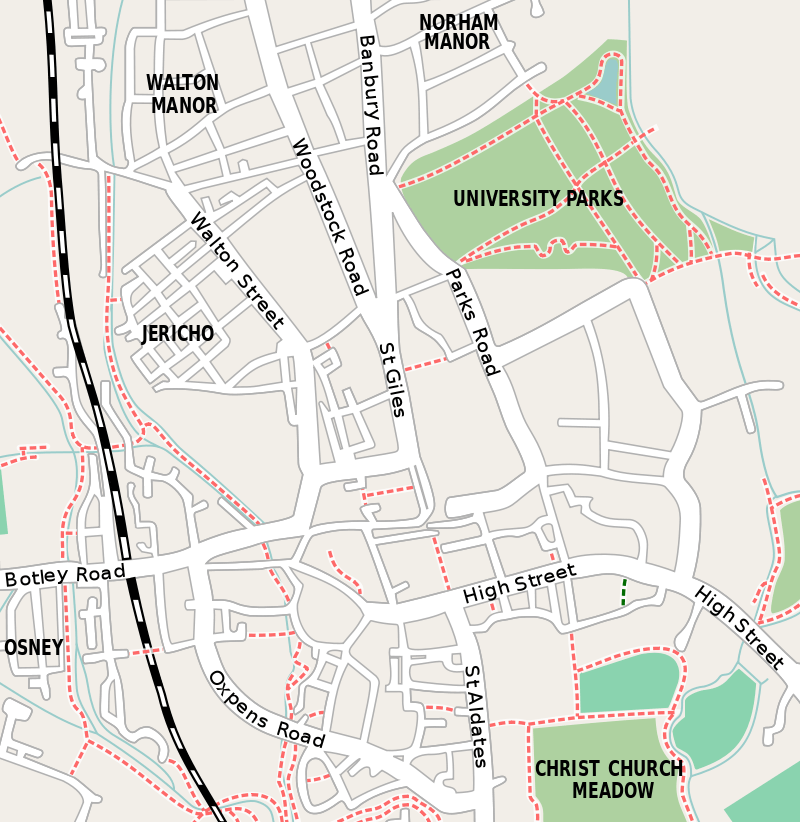Charsley's Hall
Charsley's Hall was a private hall of the University of Oxford. After 1891 it was renamed as Marcon's Hall.
| Charsley's Hall | |
|---|---|
| University of Oxford | |
| Location | Parks Road |
| Coordinates | 51.758031°N 1.256501°W |
| Established | 1851 |
| Closed | 1918, having become Marcon's Hall (1891–1918) |
| Named for | William Henry Charsley (Master) |
| Master | William Henry Charsley |
| Map | |
 Location in Oxford city centre | |
The hall was first established in 1851[1] and later given recognition under the University statute De Aulis Privatis (On private halls), passed in 1855. This allowed any Master of Arts or other member of Convocation aged at least twenty-eight years to open a private hall after obtaining a licence to do so.[2][3] The hall was in Parks Road, at the eastern corner of Museum Terrace, on the other side of the road from the Oxford University Museum,[4] and was named after its master, William Henry Charsley, of Christ Church.[5][6] At the 1871 census, it contained nine residents.[7]
Charsley's Hall had no published tuition fees, members electing their tutors and making their own arrangements for payment, but in general the terms were higher than elsewhere. Despite this, the hall was popular.[6] One writer noted in 1883
Mr Charsley is the first master who has achieved any success as the head of such an institution. His hall, however, is the resort of a class of pupils who have, for the most part, larger means than those who enter the University avowedly as frugal students, the terms being somewhat high.[8]
By 1889, migration to Charsley's was seen as a way of circumventing some requirements of the colleges, and its demise was prematurely foreseen by The Oxford Magazine.
... and yet if they, through lack of natural ability, fail to pass Mods, by a certain time, down they go and nothing is left them but to migrate to Charsley's Hall, itself perhaps to be abolished ere long. The life of a man at a private hall now-a-days is utterly different from that of a man at New Inn Hall as it used to be. Some of the restrictions (we hope Mr. Charsley will pardon us) are vexatious in the case of men residing at the Hall...[9]
Charsley's Hall features several times in The Lay of the First Minstrel, a parody of Sir Walter Scott dating from the 1870s, beginning:
It was an Oxford Scholar bright,
(The sun shone fair on Charsley's Hall,)
And he would get him thoroughly tight,
For Gilbey'll still be lord of all...[10]
In 1889–1890 Charsley's had forty-seven undergraduates, while Turrell's, the only other private hall, had seven.[11] The Master, William Henry Charsley, appears to have kept a school for boys as well as a house of the university. This is suggested as a reason for matriculations at Charsley's at an unusually young age. By the end of 1891 the name of Charsley's had disappeared,[12] as the mastership of the hall was taken over by Charles Abdy Marcon and it thus took his name as Marcon's Hall.[13] Marcon had himself been educated at Charsley's.[14]
Whitaker's Almanack for 1897 lists three private halls in the university, based on the University Calendar for 1895: Marcon's, Turrell's and Grindle's.[14] Marcon's continued under that name until C. A. Marcon retired in 1918.[15]
Notable people
- William Morfill taught philosophy and modern history at Charsley's between 1865 and 1869
- Edward John Payne completed his first degree at Charsley's in 1871
- Charles Abdy Marcon, who took his first degree at Charsley's in 1878, succeeded W. H. Charsley as Master in 1891[15]
References
- Whitaker’s Almanack for 1891, p. 641
- Statuta Universitatis Oxoniensis [Oxford University Statutes] (in Latin). University of Oxford. 1876. pp. 275–279. Retrieved 6 September 2018.
- William Geddie, Chambers's Encyclopaedia, Volume 7 (1874), p. 174: "To these may be added Charsley's Hall, being a private hall under the mastership of WH Charsley, in virtue of a statute passed in 1854..."
- The pictorial and historical gossiping guide to Oxford' James J. Moore, Herber, T Hurst
- Kelly's directory of Berkshire, Bucks and Oxon (Kelly's directories, 1883), p. 640: "... a private hall under licence from the Vice-Chancellor... There are now two of these: Charsley's Hall, in the Parks road, William Henry Charsley MA late of Christ Church, licensed master..."
- Edwin Wooton, A guide to degrees in arts, science, literature, law, music, and divinity, in the United Kingdom, the colonies, the continent and the United States (L. Upcott Gill, 1883), p. 39: "At Charsley's Hall the members elect their own tutors, with whom they make their own arrangements."
- Digest of the English Census of 1871 (Adamant Media reprint, 2004), p. 78
- The Popular Educator, p. 231
- The Oxford magazine vols. 7-8 (1889), p. 83
- From The Shotover Papers (Oxford), 17 October 1874, in Walter Hamilton, Parodies of the works of English & American authors, vol. 3, p.
- Paul John Rich, Creating the Arabian Gulf (1991), p. 231: "CHARSLEY HALL Oxford... private halls licensed by the Vice Chancellor. In 1889-90 there were two: Charsley's with 47 undergraduates, and Turrell's with 8.
- Maggie Macdonald, Oxford University Archives, quoted in Paul John Rich, Creating the Arabian Gulf (1991), pp. 231–232: "It is my guess that W. H. Charsley, the licensed master, in addition to teaching undergraduates as in a College, also taught younger boys, i.e. he ran a school. There was at least one other 14-year-old from Charsley's matriculating at the same time as Stewart. The Hall itself had ceased to operate by the end of 1891."
- Lewis Carroll, ed. Edward Wakeling, Lewis Carroll's Diaries: The Private Journals of Charles Lutwidge Dodgson (1993), pp. 47-48
- Whitaker's Almanack for 1897, p. 258
- 'MARCON, Charles Abdy', in Crockford's Clerical Directory (1930)
